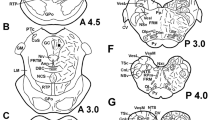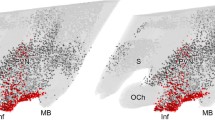Summary
The distribution of immunoreactive substance P (I-SP), somatostatin (I-SRIF), and neurotensin (I-NT) and the effect of capsaicin treatment on the concentration of these peptides was studied in the peripheral and central nervous system of the rat.
Neonatal capsaicin treatment (50 mg/kg s.c.) caused a depletion of I-SRIF as well as of I-SP in sensory nerves and in the dorsal half of the spinal cord. No recovery of the peptide content was found when examined 4 months later suggesting an irrerersible effect. I-NT, not a constituent of primary sensory neurons, was not changed in the spinal cord. None of the peptides studied was depleted in the hypothalamus or preoptic area.
Capsaicin treatment of adult rats also led to a decrease of I-SRIF and I-SP in primarh sensory neurons. The highest dose used (950 mg/kg s.c.) induced no greater depletion than the lowest one (50 mg/kg), except for I-SP in dorsal root ganglia. Intraperitoneal injection of capsaicin led to a higher degree of depletion than subcutaneous administration as examined 1 week after treatment. In contrast to neonatal treatment, the I-SRIF content was completely restored within 4 months after treatment of adult rats. The I-SP content, however, did not completely recover in all areas but remained reduced in cornea, vagus nerve, dorsal spinal cord, and medulla oblongata for up to 9 months.
Intraventricular administration of capsaicin (200 μg) caused a depletion of I-SP in the medulla oblongata but had no effect on the content of all 3 peptides in hypothalamus or preoptic area. In contrast to systemic treatment, no depletion of I-SP or I-SRIF was found in the trigeminal ganglion. Chemosensitivity of the eye was abolished after intraventricular or systemic treatment. Repeated topical application of a capsaicin solution (10 mg/ml) to the eye led within 4 h to a nearly complete depletion of I-SP in the cornea.
These experiments show that capsaicin treatment of rats caused a depletion of both I-SRIF and I-SP in primary sensory neurons. While topical or systemic capsaicin administration causes depletion in terminals, the failure of intraventricular injections of capsaicin to deplete the peptides in the trigeminal ganglion suggests that depletion of the entire neuron requires an action of capsaicin on the peripheral branch and/or the cell body.
Similar content being viewed by others
References
Arnold MA, Fernstrom JD (1980) Administration of anti0somatostatin serum to rats reverses the inhibition of pulsatile growth hormone secretion produced by injection of metergoline but not yohimbine. Neuroendocrinology 31:194–199
Ault B, Evans RH (1980) Depolarizing action of capsaicin on isolated dorsal root fibres of the rat. J Physiol 306:22P-23P
Brimijoin S, Lundberg JM, Brodin E, Hökfelt T, Nilsson G (1980) Axonal transport of substance P in the vagus and sciatic nerves of the guinea pig. Brain Res 191:443–457
Carraway R, Leeman SE (1976a) Radioimmunoassay for neurotensin, a hypothalamic peptide. J Biol Chem 251:7035–7044
Carraway R, Leeman SE (1976b) Characterization of radioimmunoassayable neurotensin in the rat. J Biol Chem 251:7045–7052
Chan-Palay V, Palay SL (1977) Immunocytochemical identification of substance P cells and their processes in rat sensory ganglia and their terminals in the spinal cord: Light microscopic studies. Proc Natl Acad Sci USA 74:3597–3601
Coggeshall RE, Coulter JD, Willis WD (1974) Unmyelinated axons in the ventral roots of the cat lumbosacral enlargement. J Comp Neurol 153:39–58
Cragg BG (1970) What is the signal for chromatolosis? Brain Res 23: 1–21
Cuello AC, Gamse R, Holzer P, Lembeck F (1981) Substance P immunoreactive neurons following neonatal administration of capsaicin. Naunyn-Schmiedeberg's Arch Pharmacol 315:185–194
Del Fiacco M, Cuello AC (1980) Substance P and enkephalin-containing neurones in the rat trigeminal system. Neuroscience 5:803–815
Forssmann WG (1978) A new somatostatinergic system in the mammalian spinal cord. Neurosci Lett 10:293–297
Gamse R, Molnar A, Lembeck F (1979) Substance P release from spinal cord slices by capsaicin. Life Sci 25:629–636
Gamse R, Holzer P, Lembeck F (1980) Decrease of substance P in primary afferent neurones and impairment of neurogenic plasma extravasation by capsaicin. Br J Pharmacol 68:207–213
Gamse R, Lackner D, Gamse G, Leeman SE (1981a) Effect of capsaicin pretreatment on capsaicin-evoked release of immunoreactive somatostatin and substance P from primary sensory neurons. Naunyn-Schmiedeberg's Arch Pharmacol 316:38–41
Gamse R, Wax A, Zigmond RE, Leeman SE (1981b) Immunoreactive substance P in sympathetic ganglia: Distribution and sensitivity towards capsaicin. Neuroscience 6:437–441
Gilbert RFT, Emson PC, Fahrenkrug G, Lee CM, Penman E, Wass J (1980) Axonal transport of neuro-peptides in the cervical vagus nerve of the rat. J Neurochem 34:108–113
Godfraind JM, Jessell TM, Kelly JS, McBurney RN, Mudge AW, Yamamoto M (1981) Capsaicin prolongs action potential duration in cultured sensory neurones. J Physiol 312: 32P
Hayes AG, Tyers MB (1980) Effects of capsaicin on nociceptive heat, pressure and chemical thresholds and on substance P levels in the rat. Brain Res 189:561–564
Henry JL, Sessle BJ, Lucier GE, Hu JW (1980) Effects of substance P on nociceptive and non-nociceptive trigeminal brain stem neurons. Pain 8:33–45
Hökfelt T, Elde R, Johansson O, Luft R, Arimura A (1975) Immunohistochemical evidence for the presence of somatostatin, a powerful inhibitory peptide, in some primary sensory neurons. Neurosci Lett 1:231–235
Hökfelt T, Elde R, Johansson O, Luft R, Nilsson G, Arimura A (1976) Immunohistochemical evidence for separate population of somatostatin-containing and substance P-containing primary afferent neurons in the rat. Neuroscience 1:131–136
Hökfelt T, Ljungdahl A, Terenius L, Elde R, Nilsson G (1977) Immunohistochemical analysis of peptide pathways possibly related to pain and analgesia: Enkephalin and substance P. Proc Natl Acad Sci USA 74:3081–3085
Holzer P, Gamse R, Lembeck F (1980) Distribution of substance P in the rat gastrointestinal tract-lack of effect of capsaicin pretreatment. Eur J Pharmac 61:303–307
Hosobuchi Y (1980) The majority of unmyelinated afferent axons in human ventral roots probably conduct pain. Pain 8:167–180
Jancsó N (1966) Desensitization with capsaicin and related acylamides as a tool for studying the function of pain receptors. In: Pharmacology of pain, Proc 3rd Int Pharmacol Meeting, Pergamon Press, Oxford, pp 33–55
Jancsó G, Király E (1980) Distribution of chemosensitive primary sensory afferents in the central nervous system of the rat. J Comp Neurol 190:781–792
Jancsó G, Király E, Jancsó-Gábor A (1977) Pharmacologically induced selective degeneration of chemosensitive primary sensory neurones. Nature 270:741–743
Jancsó G, Király E, Jancsó-Gábor A (1980) Chemosensitive pain fibres and inflammation. Int J Tiss React II:57–66
Jessell TM, Iversen LL, Cuello AC (1978) Capsaicin-induced depletion of substance P from primary sensory neurones. Brain Res 152:183–188
Jessell T, Tsunoo A, Kanazawa I, Otsuka M (1979) Substance P: Depletion in the dorsal horn of rat spinal cord after section of the peripheral processes of primary sensory neurons. Brain Res 168:247–260
Joó F, Szolcsányi J, Jancsó-Gábor A (1969) Mitochondrial alterations in the spinal ganglion cells of the rat accompanying induced by capsaicin. Life Sci 8:621–626
Katz DM, Karten HJ (1980) Substance P in the vagal sensory ganglia: localization in cell bodies and pericellular arborizations. J Comp Neurol 193:549–564
Kobayashi RM, Brown M, Vale W (1977) Regional distribution of neurotensin and somatostatin in rat brain. Brain Res 126:584–588
Lembeck F, Donnerer J (1981) Time course of capsaicin-induced functional impairments in comparison with changes in neuronal substance P content. Naunyn-Schmiedeberg's Arch Pharmacol 316:240–243
Longhurst JC, Mitchell JH, Moore MB (1980) The spinal cord ventral root: An afferent pathway of the hind-limb pressor reflex in cats. J Physiol 301:467–476
Lundberg JM, Hökfelt T, Nilsson G, Terenius L, Rehfeld J, Elde R, Said S (1978) Peptide neurons in the vagus splanchnic and sciatic nerves. Acta Physiol Scand 104:499–501
Lundberg JM, Hökfelt T, Änggard A, Uvnäs-Wallenstein K, Brimijoin S, Brodin E, Fahrenkrug J (1980) Neural peptides and neural communication. In: Costa E, Trabucchi (eds) Peripheral peptide neurons: distribution, axonal transport and some aspects on possible functions. Raven Press, New York, pp 25–36
Markwell MAK, Haas SM, Bieber LL, Tolbert NE (1978) A modification of the Lowry procedure to simplify protein determination in membrane and lipoprotein samples. Analyt Biochem 87:206–210
Maynard CW, Leonard RB, Coulter JD, Coggeshall RE (1977) Central connections of ventral root afferents as demonstrated by the HRP method. J Comp Neurol 172:601–608
Mroz E, Leeman SE (1979) Substance P. In: Jaffe BM, Behrmann MR (eds) Methods of hormone radioimmunoassay. Academic Press, New York, pp 121–137
Nagy JI, Vincent SR, Staines WA, Fibiger HC, Reisine TD, Yamamura HI (1980) Neurotoxic action of capsaicin on spinal substance P neurons. Brain Res 186:435–444
Scadding JW (1980) The permanent anatomical effects of neonatal capsaicin on somatosensory nerves. J Anat 131:473–484
Seybold JW, Elde R (1980) Immunohistochemical studies of peptidergic neurons in the dorsal horn of the spinal cord. J Histochem Cytochem 28:367–370
Szolcsányi J (1977) A pharmacological approach to elucidation of the role of different nerve fibres and receptor endings in mediation of pain. J Physiol (Paris) 73:251–259
Szolcsányi J, Joó F, Jancsó-Gábor A (1971) Mitochondrial changes in preoptic neurones after capsaicin desensitization of the hypothalamic thermodetectors in rats. Nature 229:116–117
Szolcsányi J, Jancsó-Gabor A, Joó F (1975) Functional and fine structural characteristics of the sensory neuron blocking effect of capsaicin. Naunyn-Schmiedeberg's Arch Pharmacol 287:157–169
Tessler A, Glazer E, Artymyshyn R, Murray M, Goldberger ME (1980) Recovery of substance P in the cat spinal cord after unilateral lumbosacral deafferentation. Brain Res 191:459–470
Theriault E, Otsuka M, Jessell T (1979) Capsaicin-evoked release of substance P from primary sensory neurons. Brain Res 170:209–213
Uhl GR, Kuhar MJ, Snyder SH (1977a) Neurotensin: Immunohistochemical localization in rat central nervous system. Proc Natl Acad Sci USA 74:4059–4063
Uhl GR, Bennett JP, Snyder SH (1977b) Neurotensin, a central nervous system peptide: Apparent receptor binding in brain membranes. Brain Res 130:299–313
Yaksh TL, Farb DH, Leeman SE, Jessell TM (1979) Intrathecal capsaicin depletes substance P in the rat spinal cord and produces prolonged thermal analgesia. Science 206:481–483
Zingg HH, Patel YC (1979) Somatostatin precursors: Evidence for presence in and release from rat median eminence and neurohypophysis. Biochem Biophys Res Commun 90:466–472
Author information
Authors and Affiliations
Rights and permissions
About this article
Cite this article
Gamse, R., Leeman, S.E., Holzer, P. et al. Differential effects of capsaicin on the content of somatostatin, substance P, and neurotensin in the nervous system of the rat. Naunyn-Schmiedeberg's Arch. Pharmacol. 317, 140–148 (1981). https://doi.org/10.1007/BF00500070
Received:
Accepted:
Issue Date:
DOI: https://doi.org/10.1007/BF00500070




